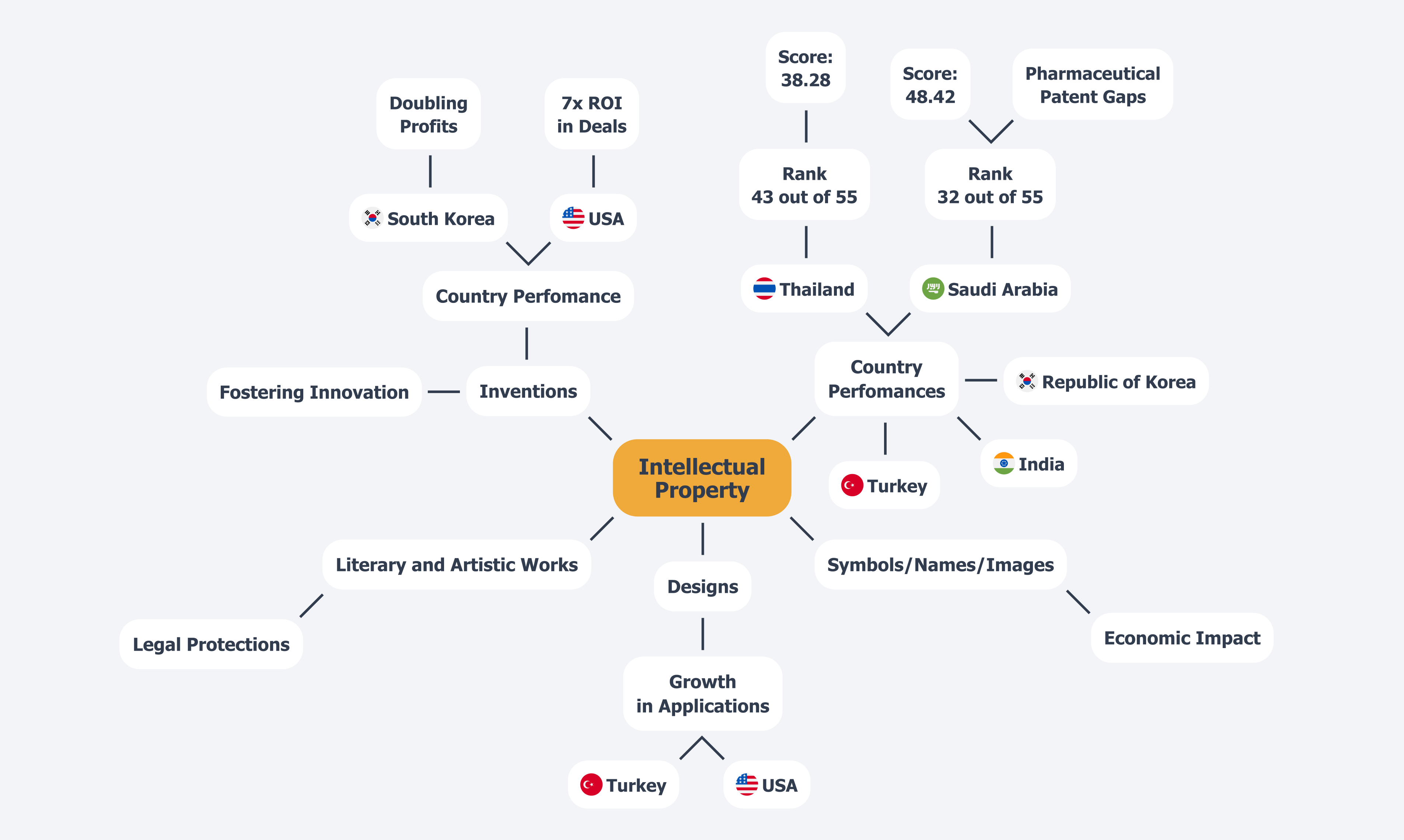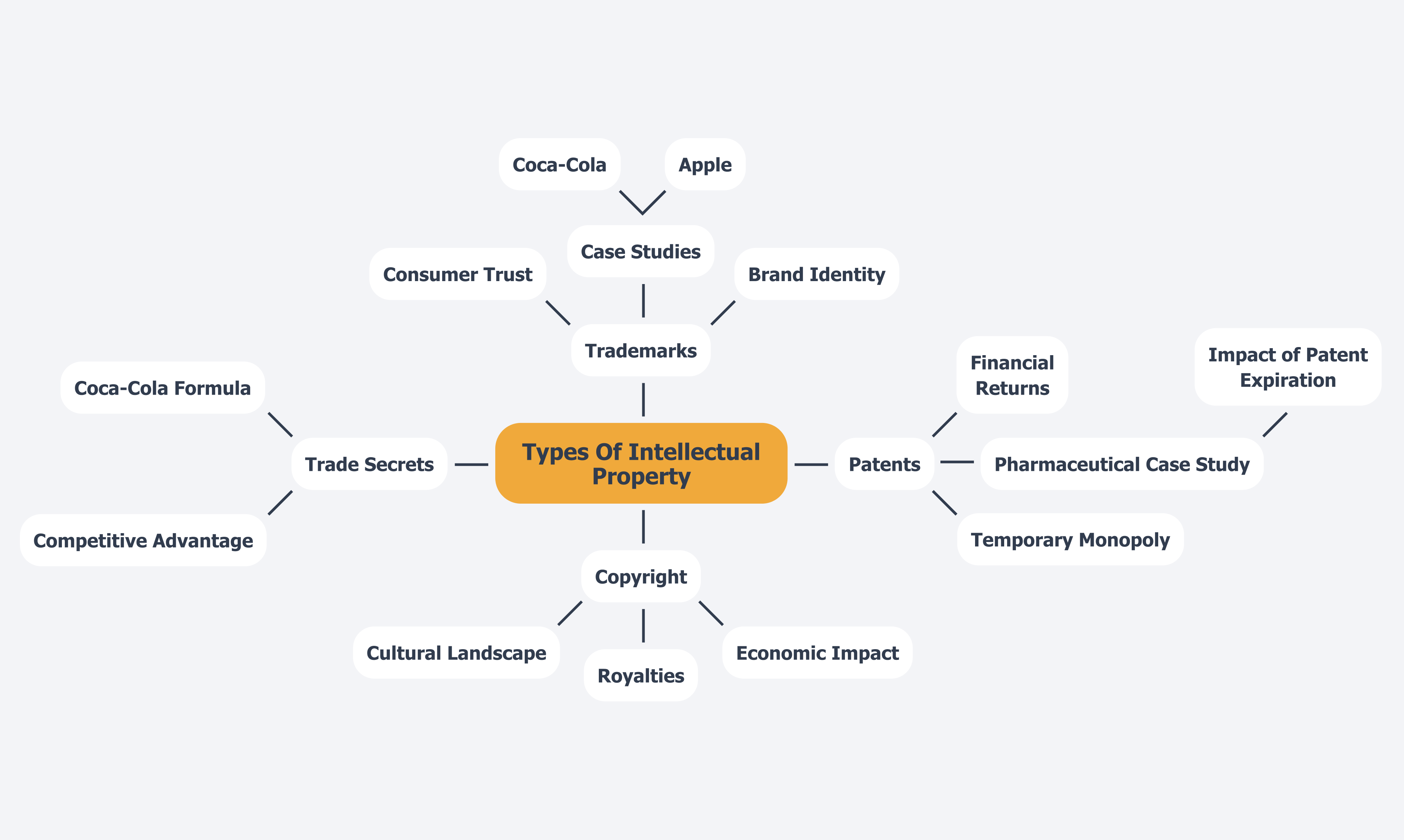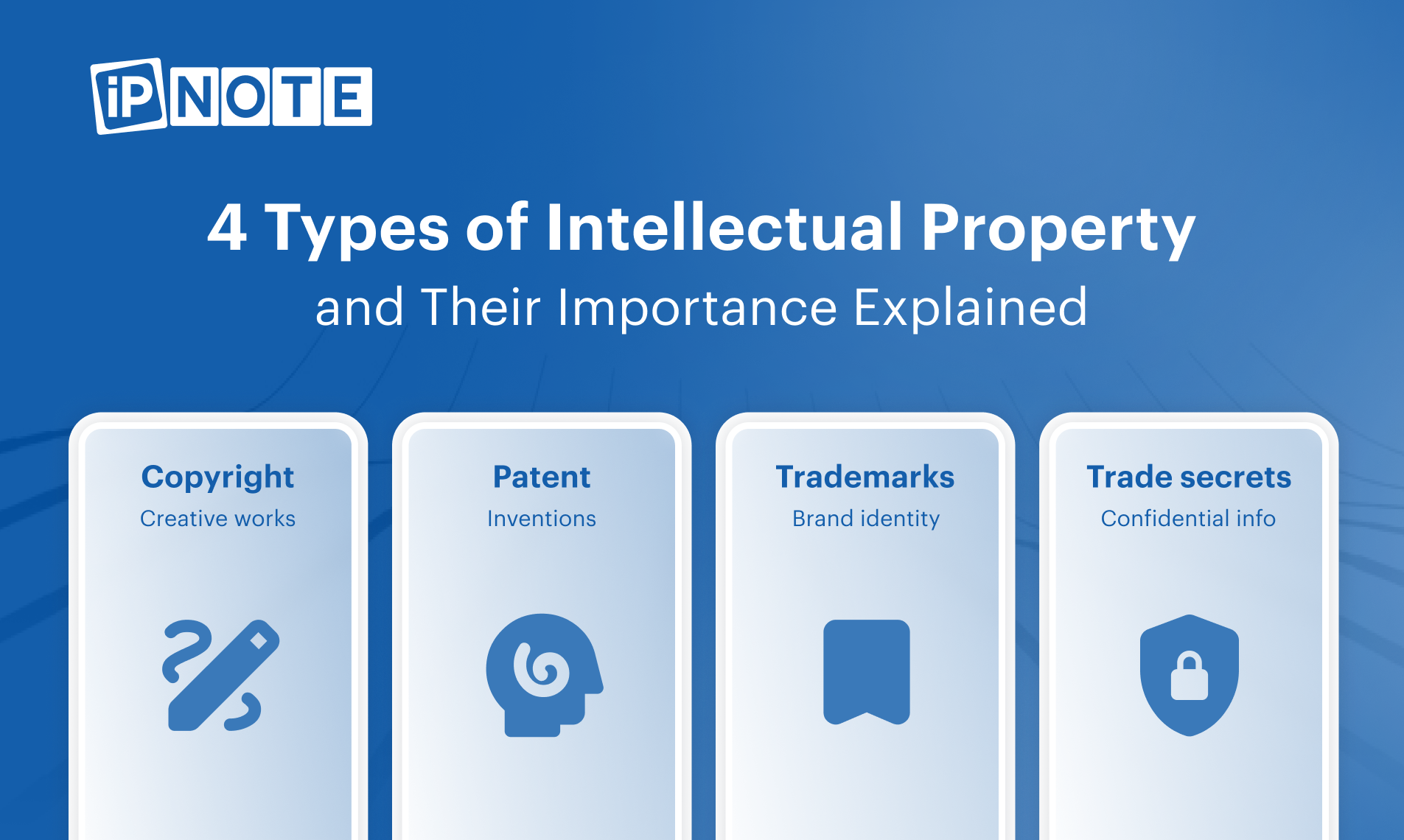Overview
The article articulates the significance of the four types of intellectual property—patents, copyrights, trademarks, and trade secrets—as essential mechanisms for safeguarding creators and stimulating innovation, which ultimately fuels economic growth. It underscores this premise by elucidating how proficient IP management catalyzes investment in novel ideas and technologies. This assertion is supported by the economic contributions of IP-protected sectors and case studies that illustrate substantial returns on investment achieved through strategic IP practices.
Such insights not only highlight the necessity of robust IP frameworks but also encourage stakeholders to actively engage in effective IP management to maximize their potential for success.
Introduction
In a world increasingly driven by innovation and creativity, the significance of intellectual property (IP) cannot be overstated. Encompassing everything from patents and copyrights to trademarks and trade secrets, IP serves as the backbone of economic growth and competitive advantage for businesses across the globe.
As countries strive to enhance their IP frameworks, the role of effective management becomes paramount. With notable success stories emerging from regions like South Korea and the USA, the transformative power of robust IP protections is evident.
This article delves into the multifaceted landscape of intellectual property, exploring its various types, their importance in fostering innovation, and the profound impact they have on economic prosperity. Through insightful case studies and current trends, readers will gain a comprehensive understanding of why navigating the complexities of IP management is crucial for sustainable growth in today’s dynamic marketplace.
Define Intellectual Property and Its Importance
Intellectual property (IP) consists of the 4 types of intellectual property, which include creations of the mind such as inventions, literary and artistic works, designs, symbols, names, and images used in commerce. It consists of various legal rights that empower creators to manage the application of their creations and secure financial advantages from them. The significance of the 4 types of intellectual property is highlighted by their role in fostering innovation and creativity through legal protections that incentivize individuals and businesses to invest in new ideas.
For instance, countries like India, Türkiye, and the Republic of Korea have emerged as notable performers in IP management, even amid a backdrop of softening global demand. The organization has played a pivotal role in this transformation, as evidenced by successful case studies where clients have achieved remarkable results. A firm in South Korea reported more than double their profits and expanded their international customer base through effective advertising campaigns and improved SEO optimization facilitated by iPNOTE. Additionally, a company in the USA experienced a 7x return on investment in the number of deals, while a Bulgarian firm attracted two major clients in a competitive market through strategic positioning and targeted advertising.
In contrast, Thailand ranks 43 out of 55 in IP framework strength, with a score of 38.28%, highlighting the challenges some regions face in protecting intellectual property. Furthermore, the case of Saudi Arabia illustrates a proactive approach to IP policy and enforcement, where improvements in online copyright and trademark enforcement have led to a ranking of 32 out of 55, with a score of 48.42%. This progress, however, unveils ongoing gaps, especially in pharmaceutical patent safeguarding. Without strong protections for the 4 types of intellectual property, creators are vulnerable to theft and exploitation, which can suppress creativity and impede economic growth.
As FBI Director Christopher Wray stated, “Defeating IP theft requires vigilance in all sectors.” The impact of the 4 types of intellectual property rights on economic growth is profound, as evidenced by the significant contributions of these IP types to national economies, reinforcing the necessity for effective IP management in today’s competitive landscape. Notably, Turkey and the US have also seen significant growth in industrial design applications, further illustrating the dynamic nature of global IP management.
The strategies developed with iPNOTE and the customer reviews highlight its commitment to improving intellectual property management, making it a reliable partner for companies that understand the complexities of intellectual property.

Explore the Four Main Types of Intellectual Property
The four primary categories of intellectual property (IP) are crucial in fostering creativity and protecting artistic endeavors:
- Patents: Legal protections granted for inventions empower inventors with exclusive rights to utilize, sell, or license their creations for a duration typically spanning 20 years. This exclusivity not only encourages innovation but also ensures that inventors can reap the rewards of their efforts without the looming threat of competition. In 2025, a significant uptick in patent filings underscored a heightened commitment to innovation across diverse sectors. Remarkably, applications for utility models surged by 3.9%, reaching 3.1 million in 2023, highlighting a broader trend towards enhanced IP protection.
- Copyrights: Copyrights serve to protect original works of authorship, encompassing literature, music, and visual arts. This protection grants creators exclusive rights to reproduce, distribute, and publicly display their works, lasting for the life of the author plus an additional 70 years. The innovative sectors increasingly rely on copyright safeguards to secure their intellectual assets, resulting in a more vibrant cultural landscape.
- Trademarks: Trademarks safeguard distinctive symbols, names, and slogans that identify goods or services, aiding consumers in distinguishing between brands. This form of IP can endure indefinitely, provided the trademark is actively utilized and renewed. In 2025, enhancements in trademark protection have further bolstered brand integrity and consumer trust within the marketplace. Furthermore, the number of protected geographical indications is estimated at 58,600, primarily covering wines and spirits, alongside agricultural and food products, underscoring the critical role of trademarks in brand differentiation.
- Trade Secrets: Trade secrets encompass confidential information that provides a competitive advantage, such as proprietary formulas, practices, and processes. Unlike patents, trade secrets are not registered and can remain protected indefinitely as long as the information is kept confidential. This form of the 4 types intellectual property is essential for businesses striving to maintain their competitive edge in dynamic markets. Grasping the 4 types intellectual property is vital for businesses aiming to adeptly navigate the complexities of IP management. As François-Adrien CHAGNOLLAUD observed, India has ascended into the top 10 filing countries for the first time in patents, trademarks, and industrial designs, reflecting the dynamic nature of global IP trends. As the landscape evolves, staying informed about the latest advancements and trends in IP protection is imperative for leveraging these assets to foster progress and growth. Additionally, the typical age of active patents varies significantly among nations, with Brazil averaging 11.5 years and Norway only 6 years, indicating differing patent management practices and their potential impact on creativity and market dynamics.
Understand the Significance of Each Type of Intellectual Property
Each of the 4 types of intellectual property (IP) plays a vital role in fostering innovation and protecting creators.
- Patents incentivize inventors by granting a temporary monopoly on their inventions, which can lead to substantial financial returns and stimulate further research and development. The pharmaceutical industry exemplifies this, having invested $83 billion in research and development in 2019 alone. A case study on major drugs like atorvastatin and clopidogrel revealed that while sales for these products plummeted by an average of 78.8% following patent expiration, the companies’ total revenues only declined by 11.9%. This suggests that companies frequently reinvest profits to create new products, alleviating the financial consequences of losing patent rights. However, a recent study of 60 FDA-approved drugs found little correlation between research and development spending and treatment costs, suggesting that other factors also shape the economics of the pharmaceutical industry, as noted by Wayne Brough.
- Copyrights, one of the 4 types of intellectual property, are essential for artists and authors, enabling them to monetize their creative works and sustain the creative industries. In 2025, the economic impact of copyrights is expected to be significant, with musicians earning substantial royalties through copyright protections. For instance, statistics indicate that the total royalties earned by musicians have seen a steady increase, showcasing how copyright laws empower artists to thrive financially while fostering a vibrant cultural landscape.
- Among the 4 types of intellectual property, trademarks are crucial for building brand identity and consumer trust in competitive markets. A strong trademark not only enhances a company’s reputation but also fosters customer loyalty. Brands like Coca-Cola and Apple illustrate how effective trademark strategies can lead to enduring market success. Users of the platform have remarked that it simplifies the process of managing trademarks, allowing clients to effortlessly choose attorneys and comprehend related fees, which improves their overall experience in handling IP needs. As one user stated, “iPNOTE is really putting its efforts in becoming the best and most-used online platform for intellectual property firms. Hats off.”
- One of the 4 types of intellectual property, Trade Secrets, protects valuable commercial information that, if revealed, could endanger a company’s competitive advantage. The Coca-Cola formula is a prime example of a trade secret that has contributed to the company’s market dominance. Grasping the wider implications of trade secrets is crucial for corporate IP managers, as safeguarding proprietary information is vital for sustaining a competitive edge in today’s fast-paced commercial landscape. iPNOTE’s Prime Ultra plan further supports this by offering customized marketing strategies, including personalized marketing tactics, SEO & social media promotion, and lowered commission rates, ensuring that enterprises can effectively manage their IP while maximizing their resources.

The Role of Intellectual Property in Economic Growth
The 4 types of intellectual property rights are essential for fostering economic growth, as they stimulate creativity and originality, leading to the development of new products, services, and technologies. By protecting IP, governments and organizations can effectively encourage investment in research and development, which is essential for maintaining a competitive edge in the global market.
For example, nations with strong IP protections typically attract higher levels of foreign direct investment, as companies are more inclined to invest in regions where their innovations are secured. Furthermore, robust IP rights significantly contribute to job creation by supporting industries that rely on creative and innovative outputs, such as technology, entertainment, and pharmaceuticals. Indeed, sectors dependent on intellectual property have been associated with considerable job growth, highlighting the necessity of a solid IP framework in promoting sustainable economic development and improving overall quality of life through innovation.
The link between strong IP rights and economic prosperity is clear, with recent data showing that inventions in assistive robotics alone have increased more than 20-fold over the last two decades, illustrating the transformative potential of effective IP management. This entity exemplifies such transformation, achieving a 7x return on investment for clients through strategic recommendations and effective advertising, even in niche markets. For instance, iPNOTE developed targeted SEO strategies for the Chinese and Japanese markets, greatly enhancing lead generation.
However, the lack of strong protections for the 4 types of intellectual property can have dire consequences; as highlighted by CRI Group, it ‘devalues corporate reputations, hinders investment, funds terrorism, and costs hundreds of thousands of individuals their livelihood each year.’
Moreover, the financial strain of defending against patent lawsuits, which can surpass $3 million, often compels companies to settle quickly, jeopardizing their operational sustainability.
As technology evolves, the complexities of maintaining strong IP rights for the 4 types of intellectual property increase, underscoring the need for robust protections in a changing landscape. The success stories of this entity, such as attracting major clients in competitive markets and doubling deal growth for firms within just two months, underscore the critical role that effective IP management plays in driving economic success.
Client testimonials highlight the platform’s effectiveness, with one stating, ‘iPNOTE makes the process of hiring foreign associates easy,’ while another remarked, ‘the communication is easy, flows very well and fast.’ These insights reflect the significant impact of iPNOTE’s services on enhancing business operations within the IP sector.
Conclusion
In the intricate landscape of intellectual property, understanding its various facets is crucial for fostering innovation and driving economic growth. This article underscores the importance of IP, detailing its four main types:
- Patents
- Copyrights
- Trademarks
- Trade secrets
Each type plays a unique role in safeguarding creators’ rights and encouraging investment in new ideas. Successful case studies from countries like South Korea and the USA demonstrate that effective management of IP can yield substantial financial returns and competitive advantages for businesses.
The significance of strong IP protections cannot be overstated; they not only incentivize innovation but also attract foreign investment and generate job growth in creative industries. The correlation between robust IP rights and economic prosperity is clear: nations that prioritize IP frameworks witness a flourishing of new products and services, contributing to their overall economic health. However, the challenges of maintaining effective IP protections in an ever-evolving technological landscape underscore the need for vigilance and proactive measures.
Ultimately, navigating the complexities of intellectual property management is vital for businesses aiming for sustainable growth. By leveraging the insights and strategies outlined in this article, companies can better protect their innovations, enhance their market positions, and contribute to a vibrant economic future. The transformative power of intellectual property, when effectively managed, can unlock unparalleled opportunities for progress and prosperity in today’s competitive marketplace.
Unlock Your Business Potential with Smart IP Management
Frequently Asked Questions
What is intellectual property (IP)?
Intellectual property (IP) consists of creations of the mind, including inventions, literary and artistic works, designs, symbols, names, and images used in commerce. It encompasses various legal rights that enable creators to manage their creations and secure financial benefits from them.
Why is intellectual property important?
Intellectual property is significant because it fosters innovation and creativity by providing legal protections that incentivize individuals and businesses to invest in new ideas.
How do different countries perform in IP management?
Countries like India, Türkiye, and the Republic of Korea have shown notable performance in IP management. For example, a South Korean firm reported more than double their profits through effective advertising and SEO optimization, while a USA company experienced a 7x return on investment in deals.
What challenges do some regions face in IP protection?
Thailand ranks 43 out of 55 in IP framework strength, indicating challenges in protecting intellectual property. In contrast, Saudi Arabia has made improvements in online copyright and trademark enforcement, ranking 32 out of 55, but still faces gaps in pharmaceutical patent protection.
What are the consequences of weak IP protections?
Without strong protections for the four types of intellectual property, creators are vulnerable to theft and exploitation, which can suppress creativity and hinder economic growth.
What is the impact of IP rights on economic growth?
The four types of intellectual property rights have a profound impact on economic growth, contributing significantly to national economies and highlighting the necessity for effective IP management in a competitive landscape.
How have Turkey and the US performed in industrial design applications?
Turkey and the US have seen significant growth in industrial design applications, further illustrating the dynamic nature of global IP management.
How does iPNOTE support businesses in IP management?
iPNOTE provides proven strategies and has received positive client testimonials, establishing itself as a trusted partner for businesses navigating the complexities of intellectual property management.






